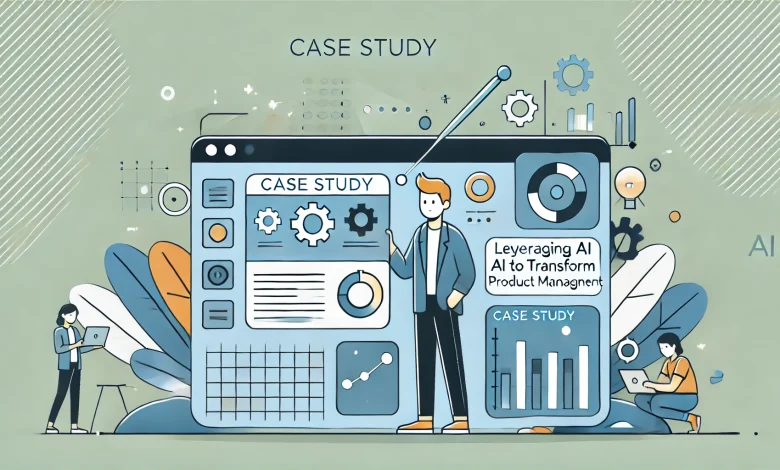Case Study: Leveraging AI to Transform Product Management at a Mid-Size FinTech Company

Introduction
In a rapidly evolving financial technology (FinTech) landscape, staying ahead of the competition requires more than just innovative products—it demands intelligent, data-driven product management.
This case study explores how a mid-size FinTech company successfully integrated AI into their product management processes, following the principles outlined in the article The Transformative Power of AI in Product Management By leveraging AI, the company was able to streamline prioritization, enhance user story definition, improve feature specification, and ultimately align their product strategy with the company’s broader goals.
Background and Challenge
The FinTech company, known for its robust digital payment solutions, faced increasing competition and a growing backlog of feature requests.
With a diverse customer base and complex product offerings, the company needed a more efficient way to manage its product roadmap and ensure that the most valuable features were prioritized.
The challenge was to integrate AI into their product management workflow to enhance decision-making, improve alignment across teams, and deliver products that met the evolving needs of their customers.
Step 1: Streamlining Prioritization with AI
Application of Concept
The first area where AI was applied was in prioritizing the product backlog.
The traditional method of manually sifting through user feedback, market trends, and business objectives was time-consuming and prone to human bias.
AI provided a solution by automating the analysis of these data sources and ranking features based on their potential impact.
High-Quality Prompt Example:
Analyze our product backlog, user feedback, and market trends to rank the top 10 features in order of their potential impact on user retention and revenue growth.Process:
The AI tool was fed data from customer feedback surveys, social media mentions, and historical sales trends.
By applying sentiment analysis and predictive modeling, the AI identified key patterns and suggested a prioritized list of features that aligned with the company’s strategic goals.
Outcome
The AI-driven prioritization process led to a more focused and efficient product development cycle. By prioritizing features that offered the highest impact with the lowest effort, the company was able to accelerate its time-to-market for key product updates.
Step 2: Enhancing User Story Definition with AI
Application of Concept
Defining clear and accurate user stories is crucial in product management. The company utilized AI-powered tools to analyze qualitative data from user interviews, surveys, and behavioral analytics. The goal was to create user stories that accurately captured user needs and reflected diverse perspectives.
High-Quality Prompt Example:
Using the following user interview transcripts and survey data, generate 5 user stories that address key pain points and reflect different user personas.Process:
The AI tool employed Natural Language Processing (NLP) to extract key themes from the data. It then generated detailed user stories that not only addressed the primary pain points but also identified potential edge cases, ensuring comprehensive coverage of user needs.
Outcome
The AI-enhanced user story definition process resulted in more accurate and relevant user stories. These stories provided the development team with a clearer understanding of user needs, reducing the likelihood of missed requirements and ensuring that the final product was aligned with customer expectations.
Step 3: Improving Feature Specification with AI
Application of Concept
Writing detailed feature specifications is essential but often labor-intensive. The company implemented AI to assist in generating comprehensive feature specifications, ensuring clarity, consistency, and completeness.
High-Quality Prompt Example:
Generate a detailed feature specification for an integrated payment gateway, including UI elements, acceptance criteria, error handling scenarios, and edge cases.Process:
The AI tool analyzed the existing user stories and business requirements to generate a detailed feature specification template. This template included UI mockups, functional requirements, and test cases, ensuring that all aspects of the feature were thoroughly documented.
Outcome
The AI-generated feature specifications improved communication between the product, design, and engineering teams. By providing a consistent and detailed specification, the company was able to reduce misunderstandings, streamline the development process, and ensure a higher quality product.
Step 4: Aligning Product Strategy with AI Insights
Application of Concept
The final step involved using AI to align the product strategy with the company’s broader business goals. By analyzing market trends, customer behavior, and competitor activity, the AI provided actionable insights that informed strategic decisions.
High-Quality Prompt Example:
Analyze current market trends and competitor offerings to identify strategic opportunities for our digital payment solutions. Suggest three strategic initiatives that align with our business goals.Process:
The AI tool conducted a thorough analysis of market data, identifying key trends and opportunities. It then generated a report outlining potential strategic initiatives, such as expanding into new markets or enhancing existing features to outpace competitors.
Outcome
By integrating AI insights into the strategic planning process, the company was able to make more informed decisions that aligned with its long-term goals. This strategic alignment helped the company stay competitive and positioned it for sustained growth.
Actual Example of Output
Final Product Vision Statement:
“To revolutionize digital payments by providing a seamless, secure, and user-friendly platform that empowers businesses to thrive in a digital-first world.”
Supporting Documents:
- Product Roadmap: Detailed quarterly phases with prioritized features and key milestones.
- User Stories: AI-generated user stories that reflect diverse user needs and pain points.
- Feature Specifications: Comprehensive specifications including UI elements, acceptance criteria, and test cases.
Impact on Product Strategy
The AI-driven approach to product management significantly enhanced the company’s ability to prioritize features, define user stories, and align product strategy with business goals.
The final product vision statement encapsulated the company’s commitment to innovation and customer-centricity, guiding the development process and ensuring that the end product met both market demands and customer expectations.
Conclusion: Realizing the Power of AI in Product Management
This case study demonstrates how the principles outlined in The Transformative Power of AI in Product Management can be effectively applied in a real-world scenario.
By leveraging AI to streamline prioritization, enhance user story definition, improve feature specification, and align product strategy, the company was able to deliver a product that not only met but exceeded customer expectations.
The successful implementation of AI in product management resulted in a more efficient development process, higher-quality products, and a stronger alignment with the company’s strategic goals.




